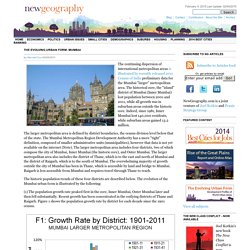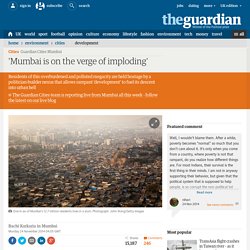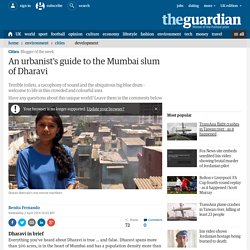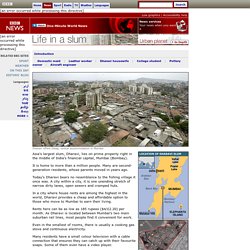

Mumbai. City map. Life in Mumbai. Mumbai: city of dreams and extreme poverty. With a population of 13 million, Mumbai is India's largest city and its most diverse, cosmopolitan and westernised.

Thriving alongside each other are the Bollywood film industry, some of the world's most opulent hotels and India's leading industrial and financial – all against a backdrop of extreme poverty. Already India's financial centre, Mumbai boomed when India emerged as Asia's leading economy. Last year its stock markets hit record highs, fuelled by investors looking for a safe haven as the global credit crisis bit elsewhere. The Mumbai paradox! The Evolving Urban Form: Mumbai. The continuing dispersion of international metropolitan areas is illustrated by recently released 2011 Census of India preliminary data for the Mumbai "larger" metropolitan area.

The historical core, the "island" district of Mumbai (Inner Mumbai) lost population between 2001 and 2011, while all growth was in suburban areas outside the historic core. Indeed, since 1981, Inner Mumbai lost 140,000 residents, while suburban areas gained 13.2 million. The larger metropolitan area is defined by district boundaries, the census division level below that of the state. The Mumbai Metropolitan Region Development Authority has a more "tight" definition, composed of smaller administrative units (municipalities), however that data is not yet available on the internet (Note). 'Mumbai is on the verge of imploding' It used to be India’s urban showpiece.

Today, its sceptre and crown have fallen down and, in a phase of cynical destruction masquerading as “development”, Mumbai has become a metaphor for urban blight. Consider these statistics. Rubbish could be its Mount Vesuvius. Some 7,000 metric tonnes of refuse is spewed out each day. Dumping grounds are choked, yet there is no government-mandated separation or recycling. Around 7.5 million commuters cram themselves into local trains every day and the fledgling metro and monorail are unlikely to make a perceptible difference in the near future.
There are 700,000 cars on the road and the authorities indirectly encourage private vehicle ownership by adding flyovers and expressways, instead of building or speeding up mass rapid transit systems. Toxic nitric oxide and nitrogen oxide levels stand at 252 microgrammes per cubic metre (mcg/m3) more than three times the safe limit of 80 mcg/m3. In Indian Slum, Misery, Work, Politics and Hope. Yet inside, carpenters are assembling furniture on the ground floor.

An urbanist's guide to the Mumbai slum of Dharavi. Dharavi in brief Everything you’ve heard about Dharavi is true … and false.

Dharavi spans more than 500 acres, is in the heart of Mumbai and has a population density more than 10 times the rest of the city. There are anywhere between 300,000 and a million people, with 750,000 being the most common estimate. There are businesses of every kind: it is something of an informal economic powerhouse. People in Dharavi live and labour, but they need better living conditions, infrastructure and sanitation. Best place The western edge of Dharavi is where its original inhabitants, the Kolis, reside. What used to be an area with thatched houses and gutter streets has now become one of the cleanest, best-maintained spots in Dharavi. Worst building Public bathrooms and toilets are some of the most poorly maintained structures, so Dharaviites take pride in having a good bathroom in their locality. How clean is Dharavi? What's the best way to get around?
What does Dharavi sound like? Dharavi Slum. Asia's largest slum, Dharavi, lies on prime property right in the middle of India's financial capital, Mumbai (Bombay).

It is home to more than a million people. Many are second-generation residents, whose parents moved in years ago. Today's Dharavi bears no resemblance to the fishing village it once was. A city within a city, it is one unending stretch of narrow dirty lanes, open sewers and cramped huts. In a city where house rents are among the highest in the world, Dharavi provides a cheap and affordable option to those who move to Mumbai to earn their living. Rents here can be as low as 185 rupees ($4/£2.20) per month. In Mumbai, the $50,000 Slum Shack. Monsoon in Mumbai. Urbanization and risks.
M.

Lakshman/Associated PressA fishermen’s settlement in Nochikuppam, Chennai destroyed by the Dec. 26, 2004 tsunami, in this Jan. 8, 2005 file photo. The number of people exposed to natural disasters is expected to more than double to 1.5 billion by 2050, with 200 million of them in India, because of rapid urbanization and the extreme weather stemming from climate change, according to the World Bank. Preventive measures will minimize damage from natural disasters, World Bank officials stressed during recent interviews in India to publicize an extensive report on the issue. Much depends on how effectively countries prepare for disasters, including installing early warning systems and builds strong infrastructure, officials say. “While exposure to natural hazards is increasing, vulnerability need not,” said Mahmoud Mohieldin, a managing director at the World Bank.
The Indian government tried to increase preparations for natural disasters, since passing the Disaster Management Act of 2005.